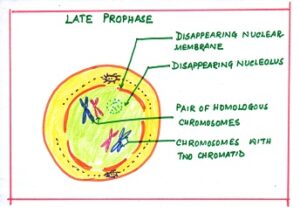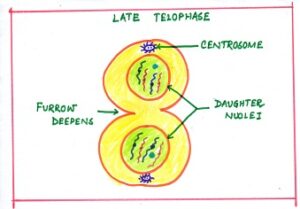CELL CYCLE REGULATION
INTRODUCTION
All living beings are made up of cells. The structural and functional unit of life is a cell which is the building block of the body. New cell arises from the pre-existing cells by the process of cell division.
Cell division occurs in all living organisms. In unicellular organisms, cell division directly produces two individuals. In multicellular organisms or higher-level organisms, life begins from a single cell, as a zygote, whIch divides and redivides mitotically into a number of cells to form a complete organism.
In multicellular organisms, there are two types of cells.
a)The somatic cells or the body cells- They form the body of an organism.
b)The reproductive cells or sex cells- They are gamete-producing cells.
WHY DO CELLS DIVIDE
The cells divide to produce new cells. The new cells are produced for the following reasons:-
i)GROWTH: During cell division, a single cell divides to produce new cells which form a cluster of similar cells to form tissues and organs.
ii)REPLACEMENT OF DEAD CELLS:- The existing cells in our body are destroyed regularly. These dead cells should be replaced by the new cells by regular cell division for the normal functioning of the body.
iii)FORMATION OF RBC:- Cell division in the bone marrow helps in the replacement of old RBC by new blood cells.
iv)REPAIR OF TISSUE:- Cells divide and new cells fill up the broken cut ends to heal wounds for repairmen of tissues.
v)REPRODUCTION:-New cells arise from pre-existing cells. The sex cells like sperms and eggs are formed because of meiotic cell division. These sex cells contain half the normal number of chromosomes. During fertilization, these sex cells combine to form the zygote. Thus cell division is essential for reproduction.
TYPES OF CELL DIVISION
There are two types of cell divisions in higher organisms:-
i)Mitosis- It occurs in somatic cells leading to growth and development.
Ii)Meiosis– It occurs in reproductive cells or sex cells leading to gamete formation.
Here is one doubt: If the sex cells or gametes undergo mitosis instead of meiosis will the offspring be affected?
Solution: certainly, because by meiosis gamete number is maintained by reductional division. But by mitosis, number of cell is increased as well as number of chromosome is same as parent. So by mitosis in gamete whole living world will be destroyed by increase of gamete numberin each generation.
( n–>2n–>4n–>8n–>16n….. and so on)
AANUVANSHIK JAANKAREE is the hereditary information present in the sex cells or gametes of the parent in hindi ( It may be X or Y in father. X or X in mother)
PHASES OF CELL DIVISION
The cell division has two phases . First is the nuclear division or karyokinesis where parent nucleus divides to form daughter neclei. This is followed by the division of cytoplasm or cytokinesis where parent cell divides into daughter cells.
BRIEF EXPLANATION OF MITOSIS
Mitosis or mitotic cell division is an equational division in which one parent cell divides to form two daughter cells. The daughter cells formed are identical to each other and also to the parent cell in every respect . In mitosis , the same normal chromosome number of the parent cell is maintained at each stage of mitotic division of the cell.
CELL CYCLE
All cells go through a basic cell cycle. These cells may vary in the time period in different stages of cell cycle. For example, bacteria divide once in every 20 minutes, epithelial cells every 8-10 minutes and onion root tip cells every 20 hours. There are three main stages in a cell cycle:
i)INTERPHASE
ii)MITOSIS OR KARYOKINESIS
iii)CYTOKINESIS
*Out of 18-20 hours that an epithelial cell takes to divide in the tissue culture
*Here are some stages common in mitosis. Plant cells don’t have centriole. Except for a few changes in cytokinesis, the rest all the stages are the same.
INTERPHASE
It is a very active phase in the cell cycle. In which DNA is duplicated. Although the cell looks to be restive, physiologically it is a very active stage. It is a preparatory phase in which a number of molecules needed for the mitotic phase or division of cell are synthesized, it is further divided into three stages:-
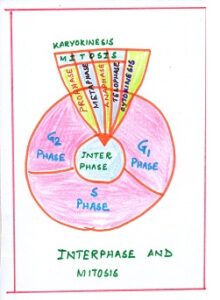
a)G1 PHASE OR GAP ONE:- Cell grows in size and RNA , proteins and enzymes needed for the next synthetic phase are synthesized.
b)S PHASE OR SYNTHETIC PHASE:- DNA synthesis takes place.
c)G2 PHASE OR GAP TWO:- Spindle and aster rays are formed.
EXPLANATION
G1 PHASE– I) Cells grow in size, cytoplasm of cell is increased.
2)Mitochondria, chloroplasts( in plant), lysosomes, endoplasmic reticulum, golgi complex, vacuoles and vesicles are produced.
3)Structural and functional proteins are formed.
4)Nucleolus produces rRNA,mRNA and tRNA.
5)Ribosomes are synthesized.
6)Metabolic rate of the cell becomes very high.
At this stage one of the two ways is taken up by the cells. Some cells withdraw and go to resting phase and others continue to divide and proceed to the next S-phase
S PHASE-1) Replication of DNA takes place. Chromosomes are duplicated.
2)Protein molecules called histones are synthesized that cover each strand of DNA.
3)Each chromosome is in the form of two chromatids.
G2 PHASE- 1)Synthesis of RNA and proteins continues.
2)Centriole replicates in animal cells. Plant cells do not have centriole.
3)Mitotic spindle and aster rays begin to get formed
4)Energy store is increased.
5)Increased metabolic state.
MITOTIC PHASE OR KARYOKINESIS
Technically it is a precise division of nuclear ,material especially of chromosome called karyokinesis. There is equal division of genes and DNA in the daughter cells. The daughter cells contain chromosomes which are identical to the mother cell.
Nuclear division or karyokinesis occurs in four distinct stages: PROPHASE, METAPHASE, ANAPHASE, TELOPHASE.
CYTOKINESIS
After the mitotic phase or karyokinesis, the cytoplasm is ready to divide. This stage is known as cytokinesis or cytoplasmic division. In this phase the cytoplasm divides, into two new daughter cells. The cell membrane gets furrowed in the middle of a cell and divides the cell organelles and the cytoplasm in such a way that the two daughter cells formed are identical in all aspects.
IMPORTANT FEATURES OF MITOSIS
| NAME OF THE STAGE | DESCRIPTION | DIAGRAM |
| a)Prophase | i)Longest phase of division.
ii)Chromosomesms are shortened by thickening iii)Nuclear membrane disintegrates. iv)nucleolus is started to disappear. v)Centrioles move to opposite poles of the cells. vi)Astrer rays radiate from centriole. |
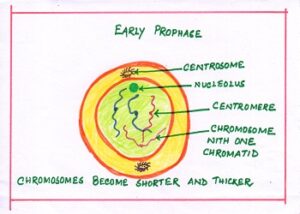
|
| b) Metaphase | i)Formation of spindle fibre
ii) Chromosomes line up at the center or equator forming equatorial or metaphase plate. iii)Chromosomes are attached to spindle fibres at the centromere region. iv)centrioles at the opposite poles. v)Nuclear membrane absent, vi) Nucleolus is absent. |
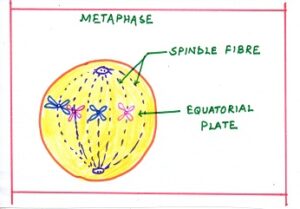 |
| c)Anaphase | i)It is a very rapid stage and the shortest stage.
ii)Centromere of each chromosomes splits into two. iii)Two chromatids of a chromosome separate and get pulled to opposite sides by the spindle fibres. iv) Shrinking of spindle fibre takes place. |
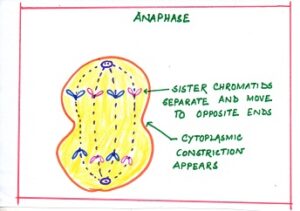 |
| d)Telophase | i)Chromosomes (now called ) reach the poles of the cells.
ii)Chromosomes uncoil, lengthen and form chromatin network again. iii)Spindle fibre stars to disappear. iv)A constriction appears at the centre of the cell. v)Nuclear membrane reappears and two nuclei are formed. vi) Nucleoli reappear in each daughter nucleus. vii)Leads to cytokinesis.
|
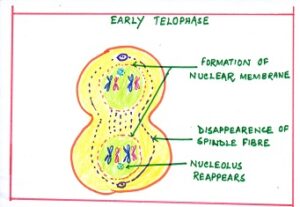
|
In animal cells, the cell membrane begins to form furrow or constriction at the equator during telophase. The constriction deepens and eventually, the cell membranes of opposite side meet at the centre. The cell finally divides into two daughter cells.
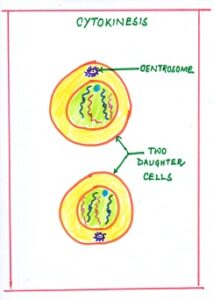
In plant cells, the presence of rigid cell wall does not perform cytokinesis by cleavage formation by cell membrane. Instead of that , cytokinesis begins by the cell plate formation in the middle of the cell during late anaphase and continues through telophase. The spindle fibre does not disappear at the equatorial plane and form a cell plate. As cell late gradually becomes distinct and develops into a new cell wall, it divides a plant cell into two.
SIGNIFICANCE OF MITOSIS
1)Identical gene composition
2)Helps in growth
3)Healing of wounds and replacement of cells
4)Regeneration and asexual reproduction
5) Mitotic division without control may give rise to tumours and cancerous growth in the body
TWO QUESTIONS WHICH YOU WOULD ASK YOUR TEACHER TO KNOW ABOUT CELL DIVISION:
(a) How do living organisms grow?
(b) By which process living organism produces sperm and egg?
——————————————————-@————————————————————————–
